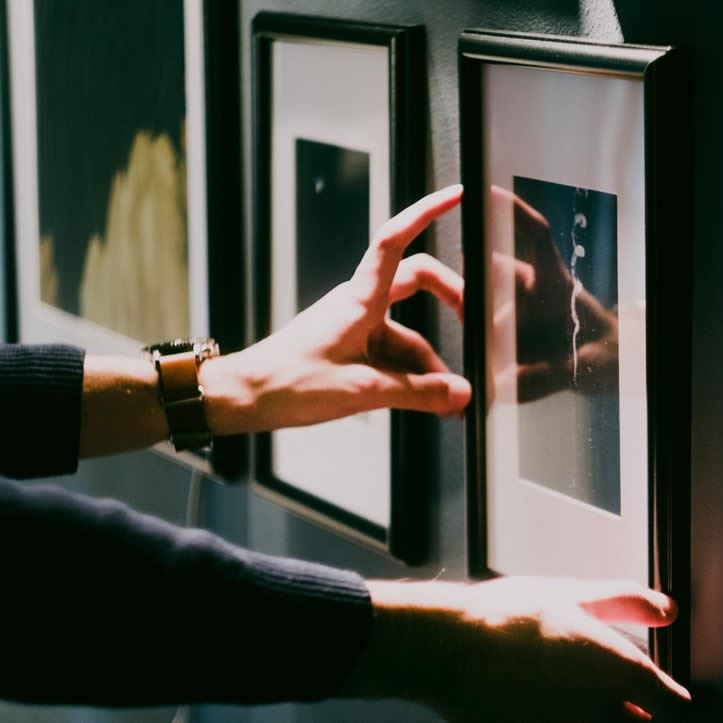Some artists intentionally paint upside down, and there are ten artists worldwide, including the Italian Fabrizio Vendramin, who engage in this unique technique. Others analyze the backs of canvases, often concealing crucial information for reconstructing an artwork's history. Then there are those who, by pure chance, discover that some well-known masterpieces have been displayed incorrectly for decades.
A few months ago in London, during the exhibition "Hilma af Klint & Piet Mondrian" at Tate Modern, which concluded in September 2023, a notable incident took place. One of the canvases by the renowned Swedish painter, Hilma af Klint, was hung upside down. A passionate visitor, familiar with the abstract and mystical artist born in Stockholm in 1862, was the first to notice. The mistake wasn't the fault of the curator or the exhibition installers but dated back to a framing change approximately forty years prior. In essence, the artwork "The Swan 14" had been presented and interpreted incorrectly for several decades, as acknowledged by the Hilma af Klint Foundation.
This surprising case is not isolated. Exploring the annals of art history reveals similar episodes, not confined to abstract works, as one might think.
Indeed, some of the most striking errors affected "Breton Village under the Snow" by Paul Gauguin and "High Grass with Butterflies" by Vincent Van Gogh. The former, dated 1894, went up for auction in 1903 shortly after the painter's death. Victor Segalen had come to French Polynesia specifically to meet Gauguin but arrived too late. Attending an auction of Gauguin's works, he noticed that the one depicting the "Niagara Falls" was, in fact, a village under the snow when viewed upside down.

On the other hand, Van Gogh's masterpiece from 1890 remained inverted for just fifteen minutes. In 1965, a student visiting the National Gallery in London noticed the mistake. The painting had been improperly stored by an attendant after cleaning.

However, artworks have been incorrectly positioned, whether for a long or short period, not only across different periods of execution. Consider "Oriental Poppies" (1928) by Georgia O'Keeffe, part of the Frederick R. Weisman Art Museum collection at the University of Minnesota. For thirty years, the oil on canvas was displayed vertically until the institution's director, Lyndel King, found a 1937 newspaper article showing the artwork hung horizontally.
Imagine Salvador Dalì's reaction upon discovering that his "The Wives of the Four Fishermen of Cadaqués," brought to London for a temporary exhibition in 1994, was hung upside down. A journalist attracted by a symbolic phallic shape noticed the error.
The list could go on, including Henri Matisse's gouache "Le Bateau" displayed at MoMA for forty-seven days upside down; Mark Rothko's "Black on Maroon," hung horizontally, then vertically, then horizontally again; and Piet Mondrian's "New York 1," perhaps the case most vividly remembered by the public. The incorrect positioning was discovered two years ago, 81 years after its execution. The grid of yellow, blue, black, and red lines was initially displayed incorrectly at MoMA in 1945 and remained so until German curator Susanne Meyer-Büser of Kunstsammlung Nordrhein Westfalen in Düsseldorf, which acquired it in 1980, noticed the mistake. However, for conservation reasons, the artwork is still displayed incorrectly at the German institution, just as it was at MoMA in 1945.

These stories, in some ways amusing, have caused no significant problems, except for interpretative misunderstandings. However, in 1878, James McNeill Whistler had an unfortunate experience. His painting "Nocturne in Black and Gold – The Falling Rocket," created between 1872 and 1877, was heavily criticized by influential Victorian critic John Ruskin. In a courtroom clash, the painting was accidentally presented upside down. Despite this mishap, Whistler emerged victorious, receiving only one shilling in compensation amid the amusement of newspapers and the public.

After all, as Leo Longanesi declared, "Art is an accident from which one never emerges unscathed."
 Born in Genoa, Milanese by adoption, Elisabetta Roncati decided to combine her university education in economics and management with her passion for culture with a goal: bringing people closer to the art market in a clear, easily understandable and professional way. Interested in all forms of artistic and cultural expressions, contemporary and otherwise, she has two great passions: textile art and African art. As an art consultant, she firmly believes that culture has the power to transcend the boundaries of individual nations, creating a global community of art lovers. In 2018 he founded the registered trademark Art Nomade Milan that she uses to speak about art and culture on the main social media platforms.
Born in Genoa, Milanese by adoption, Elisabetta Roncati decided to combine her university education in economics and management with her passion for culture with a goal: bringing people closer to the art market in a clear, easily understandable and professional way. Interested in all forms of artistic and cultural expressions, contemporary and otherwise, she has two great passions: textile art and African art. As an art consultant, she firmly believes that culture has the power to transcend the boundaries of individual nations, creating a global community of art lovers. In 2018 he founded the registered trademark Art Nomade Milan that she uses to speak about art and culture on the main social media platforms.








 This site uses anonymous technical cookies to ensure navigation and third-party cookies to monitor traffic and to offer additional services such as viewing videos or messaging systems. Without third-party cookies some pages may not work properly. Third-party cookies can track your activity and will only be installed by clicking on the "Accept all cookies" button. You can change your selection at any time by clicking on the "Cookie" link on each page at the bottom left. By clicking on one of the two buttons you declare that you have read the privacy policy and to accept the conditions.
This site uses anonymous technical cookies to ensure navigation and third-party cookies to monitor traffic and to offer additional services such as viewing videos or messaging systems. Without third-party cookies some pages may not work properly. Third-party cookies can track your activity and will only be installed by clicking on the "Accept all cookies" button. You can change your selection at any time by clicking on the "Cookie" link on each page at the bottom left. By clicking on one of the two buttons you declare that you have read the privacy policy and to accept the conditions.